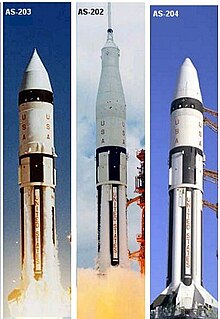
Back Saturn IB Afrikaans ساتورن IB Arabic Saturn IB Azerbaijani Сатурн IB Bulgarian Saturn IB Catalan ساتورن IB CKB Saturn IB Czech Saturn IB Danish Saturno IB Spanish Saturn IB Basque
 Three launch configurations of the Apollo Saturn IB rocket: no spacecraft (AS-203), command and service module (AS-202), and Lunar Module (Apollo 5) | |
| Function | Apollo spacecraft development; S-IVB stage development in support of Saturn V; Skylab crew launcher |
|---|---|
| Manufacturer | Chrysler (S-IB) Douglas (S-IVB) |
| Country of origin | United States |
| Size | |
| Height | 141.6 ft (43.2 m) without payload[1] |
| Diameter | 21.67 ft (6.61 m)[1] |
| Mass | 1,300,220 lb (589,770 kg) without payload[2] |
| Stages | 2 |
| Capacity | |
| Payload to LEO | |
| Altitude | 87.5 nmi (162.1 km; 100.7 mi) |
| Mass | 21,000 kg (46,000 lb)[3] |
| Launch history | |
| Status | Retired |
| Launch sites | Cape Canaveral, LC-34 and LC-37 Kennedy, LC-39B |
| Total launches | 9 |
| Success(es) | 9 |
| First flight | February 26, 1966 |
| Last flight | July 15, 1975 |
| Type of passengers/cargo | Apollo CSM, Uncrewed Apollo LM |
| First stage – S-IB | |
| Height | 24.44 m (80.17 ft) |
| Diameter | 6.53 m (21.42 ft) |
| Empty mass | 42,000 kg (92,500 lb) |
| Gross mass | 441,000 kg (973,000 lb) |
| Propellant mass | 399,400 kg (880,500 lb) |
| Powered by | 8 × H-1 |
| Maximum thrust | 7,100 kN (1,600,000 lbf) |
| Specific impulse | 272 s (2.67 km/s) |
| Burn time | 150 seconds |
| Propellant | LOX / RP-1 |
| Second stage – S-IVB | |
| Height | 17.81 m (58.42 ft) |
| Diameter | 6.53 m (21.42 ft) |
| Empty mass | 10,600 kg (23,400 lb) |
| Gross mass | 114,300 kg (251,900 lb) |
| Propellant mass | 103,600 kg (228,500 lb) |
| Powered by | 1 × J-2 |
| Maximum thrust | 890 kN (200,000 lbf) |
| Specific impulse | 420 s (4.1 km/s) |
| Burn time | 480 seconds |
| Propellant | LOX / LH2 |
The Saturn IB[a] (also known as the uprated Saturn I) was an American launch vehicle commissioned by the National Aeronautics and Space Administration (NASA) for the Apollo program. It uprated the Saturn I by replacing the S-IV second stage (90,000-pound-force (400,000 N), 43,380,000 lb-sec total impulse), with the S-IVB (200,000-pound-force (890,000 N), 96,000,000 lb-sec total impulse). The S-IB first stage also increased the S-I baseline's thrust from 1,500,000 pounds-force (6,700,000 N) to 1,600,000 pounds-force (7,100,000 N) and propellant load by 3.1%. This increased the Saturn I's low Earth orbit payload capability from 20,000 pounds (9,100 kg) to 46,000 pounds (21,000 kg), enough for early flight tests of a half-fueled Apollo command and service module (CSM) or a fully fueled Apollo Lunar Module (LM), before the larger Saturn V needed for lunar flight was ready.
By sharing the S-IVB upper stage, the Saturn IB and Saturn V provided a common interface to the Apollo spacecraft. The only major difference was that the S-IVB on the Saturn V burned only part of its propellant to achieve Earth orbit, so it could be restarted for trans-lunar injection. The S-IVB on the Saturn IB needed all of its propellant to achieve Earth orbit.
The Saturn IB launched two uncrewed CSM suborbital flights to a height of 162 km, one uncrewed LM orbital flight, and the first crewed CSM orbital mission (first planned as Apollo 1, later flown as Apollo 7). It also launched one orbital mission, AS-203, without a payload so the S-IVB would have residual liquid hydrogen fuel. This mission supported the design of the restartable version of the S-IVB used in the Saturn V, by observing the behavior of the liquid hydrogen in weightlessness.
In 1973, the year after the Apollo lunar program ended, three Apollo CSM/Saturn IBs ferried crews to the Skylab space station. In 1975, one last Apollo/Saturn IB launched the Apollo portion of the joint US-USSR Apollo–Soyuz Test Project (ASTP). A backup Apollo CSM/Saturn IB was assembled and made ready for a Skylab rescue mission, but never flown.
The remaining Saturn IBs in NASA's inventory were scrapped after the ASTP mission, as no use could be found for them and all heavy lift needs of the US space program could be serviced by the cheaper and more versatile Titan III family and also the Space Shuttle.
- ^ a b Cite error: The named reference
AS201was invoked but never defined (see the help page). - ^ Wade, Mark. "Saturn IB". Encyclopedia Astronautica. Archived from the original on May 14, 2011. Retrieved March 17, 2011.
- ^ Hornung, John (2013). Entering the Race to the Moon: Autobiography of an Apollo Rocket Scientist. Williamsburg, Virginia: Jack Be Nimble Publishing. ISBN 9780983044178.
Cite error: There are <ref group=lower-alpha> tags or {{efn}} templates on this page, but the references will not show without a {{reflist|group=lower-alpha}} template or {{notelist}} template (see the help page).